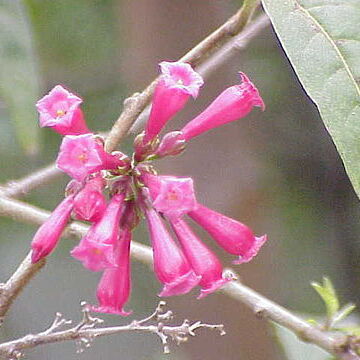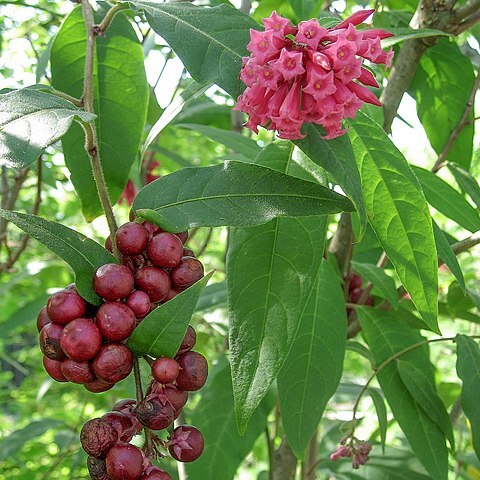Unarmed shrubs or trees to 12 m tall with simple or dendritic hairs, some species glabrous; trunks not exceeding 15 cm d.b.h.; twigs glabrous to velutinous, mostly slender. Leaves simple and entire, pinnately nerved, mostly glabrous above and variously pubescent beneath, mostly short petiolate; minor leaves present or not. Inflorescence axillary, sometimes appearing terminal, often bracteate, mostly a congested raceme or panicle but occasionally open or solitary and sessile; pedicels short, bracteolate. Flowers sometimes nocturnally opening and scented; calyx cyathiform to tubular, variously pubescent, lobed less than halfway down, the lobes sometimes unequal, not much accrescent in fruit; corolla tubular or salverform, often slightly zygomorphic, the tube obconical or with a
Woody shrubs or small trees, glabrous, or pubescent with simple, forked or dendritic hairs. Leaves mostly alternate, sometimes paired, simple, entire, petiolate. Inflo– rescence usually raceme-or panicle-like, axillary or terminal. Flowers bisexual, sometimes slightly zygomorphic, often subtended by a small bract. Calyx tubular, 5–7–lobed. Corolla tubular or salver-shaped (not in Australia), variously coloured; tube often slightly inflated towards limb; limb shortly 5–7–lobed, the lobes valvate in bud. Stamens 5, equal or subequal, variously inserted on corolla-tube; anthers bilocular, versatile, dehiscing by longitudinal slits. Ovary bilocular; stigma capitate. Fruit a succulent berry. Seeds prismatic or ovoid.
bulge along its length, the lobes short, often recurved, the location of pubescence often characteristic for species; stamens 5, equal or subequal, filaments inserted along the corolla tube, variously pubescent, geniculate or appendaged, the anthers clustered, included, bithecate, dehiscent longitudinally; ovary on a small glandular disc or short stipe, glabrous, 2-loculed with 4-50 ovules, the stigma included or exserted, small. Fruit a short-stipitate, fleshy or juicy berry, rarely with one or two apical sutures; seeds variable in shape and size; embryo straight or somewhat curved in fleshy endosperm.
Unarmed shrubs or occasionally small trees. Lvs simple, entire, foetid when bruised, hairy or glabrous. Panicle of few to many clusters of axillary or terminal cymes; fls often fragrant. Calyx 5-(6)-lobed, campanulate to tubular; lobes small, < tube. Corolla tubular to salverform, with throat widened or contracted, most colours except blue; lobes 5, short. Stamens 5, inserted from around middle to near base of corolla tube, included, sometimes appendaged. Stigma usually 2-lobed. Fr. a berry, often scarcely succulent. Seeds few, of moderate size.
Corolla deep yellow to reddish or purplish, rarely greenish-white or white, often very fragrant, sometimes only so at night, tubular-infundibuliform, salviform or somewhat trumpet-shaped, the tube sometimes obconical or with a bulge, often constricted to bladdery at the throat; limb short, regularly revolute, 5-lobed to deeply divided, subplicate, the lobes short, often with involute, tomentose or pubescent margins, spreading or reflexed, with valvate or induplicate-valvate aestivation.
Stamens equal or subequal, attached from the middle or higher within the corolla tube and running downwards as ridges, very rarely totally free, mostly included; free part of filaments filiform, often thickened, geniculate or appendaged at or near the base, variously pubescent to glabrous; anthers short, ± globose or obcordate in outline, medifixed, the thecae ± parallel, dehiscing by longitudinal slits.
Seeds few or solitary by abortion, variable in shape and size, compressed, dorsally convex, the internal face angular; testa often nearly smooth; embryo orbicular, ovate or oblong in outline, usually thick, straight or somewhat curved in the axis of the fleshy endosperm, with the terete radicle inferior, much narrower (or scarcely so) than the small, compressed, foliaceous, often semi-terete cotyledons.
Ovary on a short, stout stipe or subsessile, ovoid or globose, 2(rarely only incompletely)-locular, the middle dissepiment with subglobose placentas, the ovules few–many in each locule, hemitropous; style filiform, usually with minute glands upwards; stigma small, ± capitate, subpeltate, concave or 2-lobed, rarely clavate, included or exserted.
Calyx shorter than the corolla tube, tubular to campanulate or cupular, 5-dentate to deeply divided, the lobes subequal or occasionally unequal, usually shorter than the tube, with valvate aestivation, persistent in fruit, not very accrescent.
Cymes axillary or sometimes appearing terminal, extended, racemiform to more often shortened, corymbiform, spiciform or fasciculiform, sometimes combined into terminal, paniculiform inflorescences; bracts and bracteoles often present.
Fruit blackish to violaceous, sometimes reddish, rarely white, shortly stipitate, baccaceous, ± globose or ovoid to obovoid, fleshy or juicy, (1)2(4)-locular, indehiscent, rarely with 1–2 apical sutures.
Leaves solitary, alternate, rarely in pairs, mostly shortly petiolate, ± entire, often gradually passing into bracts; pseudostipules often present in the axils.
Flowers (4)5(6)-merous, actinomorphic, occasionally slightly zygomorphic, usually shortly pedicellate, sometimes opening at night.
Erect or drooping shrubs or small trees, sometimes scandent, glabrous to tomentose with simple or branched hairs.
Disk glandular, rather thick or membranous and cupular, occasionally inconspicuous.


